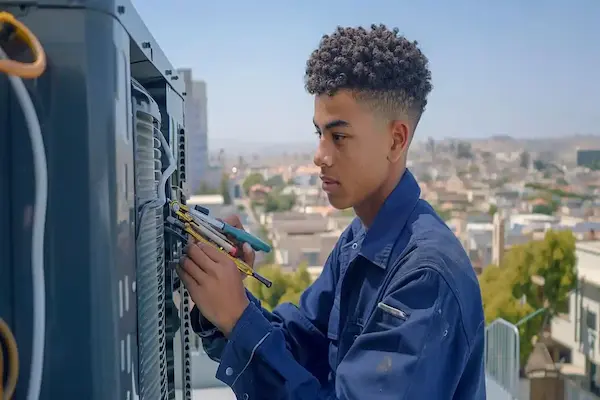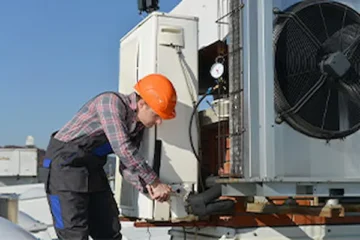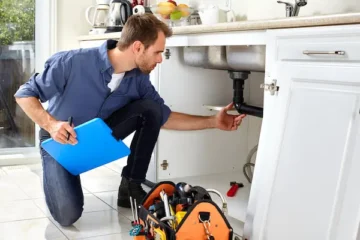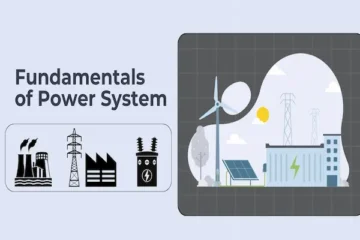Introduction to HVAC (free to learn)
Fundamentals, basic diagnostics, safety, and certification pathway. Flexible, certified classes.
Anúncios
Start Your Career in Heating and Cooling Systems
Learning HVAC skills doesn’t require expensive trade school tuition or lengthy classroom programs.
Many high-quality free online HVAC courses are available for beginners who want to explore heating, ventilation, and air conditioning careers without upfront costs.
These courses cover basic system types, refrigeration cycles, and fundamental concepts that form the foundation of HVAC work.
Free online programs let you learn at your own pace while exploring whether HVAC is right for you.
You can study basic system operations, safety procedures, and troubleshooting methods from home.
This approach helps you build knowledge before deciding to pursue formal training or certification.
The key is knowing which free resources offer real value and how to use them effectively.
You’ll need to understand core fundamentals, develop essential technical skills, and learn about certification options.
With the right approach, free online courses can give you a solid foundation for entering the HVAC field.
Getting Started With Free Online HVAC Courses
Most free online HVAC programs require only basic computer skills and an internet connection to begin.
You can expect to learn HVAC basics through videos, interactive content, and hands-on simulations before moving to advanced topics.
Finding the Best Beginner-Friendly HVAC Programs
Look for programs that start with basic HVAC concepts before moving to complex systems.
The best courses cover AC split systems, mini-split systems, heat pumps, and furnaces in simple terms.
Key features to look for:
- Clear video explanations
- 3D simulations and animations
- Step-by-step presentations
- Basic refrigeration cycle training
Check if the program offers certificates of completion.
Some courses partner with accredited universities to provide recognized credentials.
Read student reviews to find programs with high ratings.
Popular platforms like Udemy host courses with thousands of enrolled students.
Make sure the course covers both theory and practical applications.
Good programs include diagnostic training and real-world scenarios you will face as a technician.
Enrollment Requirements and Accessibility
Most free online HVAC training programs have no enrollment requirements.
You can start immediately without prior experience or education.
You need a computer or tablet with internet access.
Some courses work on smartphones, but larger screens make viewing diagrams easier.
Basic requirements include:
- Stable internet connection
- Updated web browser
- Email address for account creation
- Basic reading skills at 8th grade level
Many programs offer self-paced learning.
You can study when it fits your schedule without fixed class times.
Some courses require you to complete modules in order.
Others let you jump to specific topics that interest you most.
What to Expect From a Free Online HVAC Training
Free HVAC courses typically start with heating, ventilation, air conditioning, and refrigeration basics.
You will learn how different systems work and their main components.
Expect to spend 20-40 hours completing a basic program.
Some intensive courses require up to 100 hours of study time.
Common course content includes:
- System types and components
- Refrigeration cycle principles
- Basic troubleshooting methods
- Safety procedures and protocols
- Tool identification and usage
You will watch video demonstrations of real equipment.
Many courses include virtual labs where you practice skills in simulated environments.
Most programs test your knowledge with quizzes and assignments.
You must pass these to earn your certificate of completion.
Some courses prepare you for industry certifications like Section 608 EPA certification.
This credential is required for working with refrigerants professionally.

Core Fundamentals of HVAC Systems
HVAC systems control temperature, air quality, and air movement in buildings through heating, cooling, and ventilation processes.
These systems use specific components like compressors, evaporators, and ductwork to move air and regulate indoor climate through the refrigeration cycle.
Understanding Heating, Ventilation, and Air Conditioning
Heating systems warm your indoor air during cold weather. They use furnaces, heat pumps, or boilers to create heat. Gas furnaces burn natural gas to heat air. Electric heat pumps move heat from outside air into your home.
Ventilation moves fresh air in and stale air out. This process removes odors, moisture, and pollutants. Good ventilation keeps your indoor air healthy and comfortable.
Air conditioning cools and removes humidity from indoor air. It uses refrigerant to absorb heat from inside air and release it outside. The system also filters air as it moves through your home.
These three functions work together in most modern HVAC systems. They maintain comfortable temperatures year-round while keeping air fresh and clean.
Major Components and How They Work
The compressor pumps refrigerant through the system. It increases pressure and temperature of the refrigerant gas. This component works like the heart of your cooling system.
The evaporator coil sits inside your home. Cold refrigerant flows through it and absorbs heat from indoor air. This makes the air cooler before it goes back into your rooms.
The condenser coil releases heat outside your home. Hot refrigerant flows through it and gives up heat to outdoor air. A fan helps move air across the coil.
Ductwork carries heated or cooled air throughout your building. Supply ducts bring conditioned air to rooms. Return ducts bring air back to the system for treatment.
The thermostat controls when your system runs. You set your desired temperature and it tells the system when to heat or cool.
Key HVAC Terminology for Beginners
BTU means British Thermal Unit. It measures heating and cooling capacity. Higher BTU numbers mean more heating or cooling power.
SEER stands for Seasonal Energy Efficiency Ratio. It measures how efficiently an air conditioner uses electricity. Higher SEER ratings mean lower energy costs.
CFM means Cubic Feet per Minute. This measures how much air moves through your system. Proper CFM ensures good air circulation.
Refrigerant is the chemical that moves heat in your system. Common types include R-410A and R-32. It changes from liquid to gas and back again.
Load refers to how much heating or cooling your space needs. Factors like insulation, windows, and climate affect your load.
Introduction to the Refrigeration Cycle
The refrigeration cycle moves heat from inside your home to outside. It uses four main steps that repeat continuously.
Step 1: Compression – The compressor squeezes refrigerant gas. This makes it very hot and high pressure.
Step 2: Condensation – Hot refrigerant flows to the outdoor coil. It releases heat and turns into liquid.
Step 3: Expansion – Liquid refrigerant passes through a small opening. This drops its pressure and temperature quickly.
Step 4: Evaporation – Cold refrigerant enters the indoor coil. It absorbs heat from room air and turns back into gas.
This cycle repeats over and over to keep removing heat from your indoor air. The same process works in reverse for heat pumps during heating mode.
Essential Skills and Safety for HVAC Beginners
Learning proper tool use, basic troubleshooting, and safety practices forms the foundation of effective HVAC training.
These core skills help you work safely and efficiently in heating, ventilation, and air conditioning systems.
Proper Use of Tools and Equipment
HVAC work requires specific tools for different tasks.
Refrigeration gauges measure system pressures and help diagnose problems. You need to read these gauges correctly to understand how systems work.
Multimeters test electrical components like motors and thermostats. Always set the meter to the right setting before testing. Wrong settings can damage the tool or give false readings.
Pipe cutters and flaring tools help you work with refrigeration lines. Clean cuts prevent leaks. Poor cuts cause system failures and waste time.
Basic hand tools include screwdrivers, wrenches, and pliers.
Keep tools clean and organized. Dirty tools can contaminate refrigeration systems.
Digital thermometers measure air and surface temperatures. Accurate readings help you find problems faster. Check your thermometer settings before each use.
Basic Troubleshooting Techniques
Start with simple checks before complex diagnosis.
Look for obvious problems like loose connections or dirty filters. Many issues have easy fixes.
Check power first. Make sure units have electricity. Test outlets and circuit breakers. No power means no operation.
Listen to the system. Strange noises often point to specific problems. Grinding sounds suggest motor issues. Hissing might mean refrigerant leaks.
Feel air temperatures at vents. Hot air from cooling systems shows problems. Cold air from heating systems needs attention.
Use your nose to detect unusual smells. Burning odors suggest electrical problems. Sweet smells might indicate refrigerant leaks.
Write down what you find. Good notes help you track problems and solutions. This builds your troubleshooting skills over time.
Safety Practices in HVAC Work
Electrical safety protects you from shocks and burns. Turn off power before working on systems. Use lockout/tagout procedures. Test circuits before touching wires.
Chemical safety matters when handling refrigerants. Wear safety glasses and gloves. Work in ventilated areas. Never mix different refrigerant types.
Personal protective equipment includes safety glasses, work gloves, and steel-toe boots. Wear PPE every time you work. Replace damaged equipment right away.
Ladder safety prevents falls. Check ladders before climbing. Keep three points of contact. Never overreach while on a ladder.
Know emergency procedures.
Learn where fire extinguishers and first aid kits are located. Understand how to shut off gas and electricity quickly.
Certification Pathways and Next Steps
Getting certified after completing free online HVAC courses requires specific steps and government approvals.
The EPA 608 certification is mandatory for all HVAC technicians, while additional certifications can boost your career prospects and earning potential.
Understanding EPA 608 and Its Importance
The EPA 608 certification is required by law for anyone who works with refrigerants.
You cannot legally service HVAC systems without this certification.
This certification has four main types:
- Type I: Small appliances like window units
- Type II: High-pressure appliances
- Type III: Low-pressure appliances
- Universal: Covers all three types above
You must pass a written exam to get EPA 608 certified. The test covers refrigerant handling, safety procedures, and environmental protection rules.
Most employers require EPA 608 certification before hiring. Without it, you cannot legally buy or handle refrigerants. The certification never expires once you earn it.
Progressing to Advanced HVAC Certifications
After getting EPA 608, several advanced certifications can improve your job prospects. These certifications show employers you have specialized skills.
Popular Advanced Certifications:
- NATE (North American Technician Excellence)
- HVAC Excellence certifications
- Manufacturer-specific training (Carrier, Trane, etc.)
- Electrical certifications
NATE certification is widely recognized by employers. It covers installation, service, and repair of HVAC systems. You can get certified in specific areas like heat pumps or gas heating.
Some states require additional licenses to work as an HVAC technician. Check your state’s requirements before starting work. Many states accept online HVAC training as part of their licensing process.
Building a Career With Online HVAC Credentials
Online HVAC training gives you flexibility to learn while working other jobs. Many programs connect students with local employers who need trained technicians.
Entry-level HVAC jobs typically require EPA 608 plus basic technical knowledge. Your online course certificates can help prove your skills to employers.
Career Growth Path:
- Get EPA 608 certification
- Find entry-level technician position
- Gain hands-on experience
- Pursue advanced certifications
- Consider specializations or supervisory roles
Some companies will pay for additional training once you’re hired. This makes online courses a smart starting point for your HVAC career.
Building relationships with instructors and classmates can lead to job opportunities. Many online programs have job placement assistance to help graduates find work.
Maximizing Your Free Online HVAC Learning Experience
Getting the most from your free online HVAC training requires smart study habits, full use of available resources, and connecting with other learners. These strategies help you build real skills and knowledge that employers value.
Self-Paced Learning Strategies
Create a daily study schedule and stick to it. Set aside 1-2 hours each day for your online HVAC training. This keeps information fresh in your mind.
Break large topics into smaller chunks. Study one system at a time, like heating before moving to cooling. This prevents feeling overwhelmed.
Take notes by hand while watching videos. Writing helps your brain remember key facts about HVAC systems and procedures.
Practice what you learn immediately:
- Draw system diagrams after each lesson
- Quiz yourself on component names
- Explain concepts out loud
Review previous lessons weekly. HVAC knowledge builds on itself, so reviewing keeps earlier concepts sharp. Set calendar reminders to go back through older material.
Use the pause button often. Stop videos to think about what you learned or look up unfamiliar terms.
Utilizing Course Assessments and Resources
Complete every quiz and test available. These show you what you know and what needs more study. Many free courses offer practice exams.
Download all course materials. Save PDFs, worksheets, and reference guides to your device. You can study these offline anywhere.
Watch videos multiple times. First time for general understanding, second time to take detailed notes. This helps complex HVAC concepts stick better.
Key resources to use:
- Interactive system diagrams
- Troubleshooting flowcharts
- Component identification guides
- Safety procedure checklists
Ask questions in course forums. Most free HVAC programs have discussion areas where you can get help from instructors or other students.
Print important reference materials. Having physical copies of wiring diagrams and system specs helps during hands-on practice.
Community Support and Networking Opportunities
Join online HVAC student groups on social media. Facebook and Reddit have active communities where beginners share tips and ask questions.
Connect with local HVAC professionals. Many are willing to mentor new students or answer questions about the field.
Attend virtual study sessions when available. Some free programs offer group learning opportunities with other students.
Networking benefits include:
- Real-world job advice
- Industry updates and trends
- Equipment recommendations
- Local training opportunities
Share your learning progress online. Post about your coursework to connect with others taking similar programs. This builds your professional network early.
Look for local HVAC meetups or trade shows. These events let you meet professionals and learn about job opportunities in your area.





